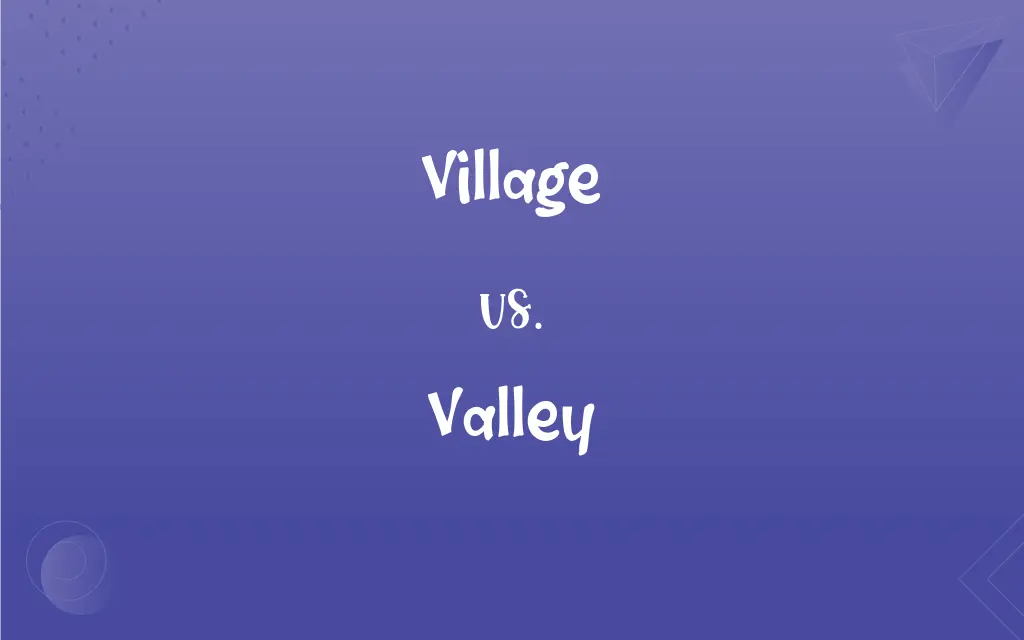Village vs. Valley: What's the Difference?
Edited by Aimie Carlson || By Harlon Moss || Updated on November 8, 2023
A village is a small community in a rural area, while a valley is a low area between hills or mountains, often with a river running through it.

Key Differences
A village is a human settlement or community that is larger than a hamlet but smaller than a town. Villages are typically found in rural areas and are characterized by a sense of close community ties, often with a population of a few hundred to a few thousand. A valley, on the other hand, is a geographical feature found between mountains or hills. It is a low area of land where you might find streams or rivers flowing, and it is formed by erosion or geological activity over time.
The concept of a village is associated with a small-scale, simple form of living, with local governance and a mostly agricultural or self-sustaining economy. Valleys can be vast or small, inhabited or uninhabited, and can serve as agricultural land, recreation spots, or simply as natural landscape features. Villages are specifically human-centric locales, whereas valleys are natural formations.
Villages play a crucial role in the cultural and social fabric of a region, often preserving traditions, dialects, and customs that might be lost in larger cities. Valleys can also be culturally significant, as they may be the cradle of civilizations, provide routes for migration, or hold historical significance due to events that took place there. While a village is a setting for human life and activity, a valley can influence the climate, biodiversity, and even the history of the areas it encompasses.
In literature and the arts, a village often symbolizes quaintness, tradition, and a slower pace of life, potentially serving as a backdrop for stories about community and relationships. Valleys are often depicted as serene, fertile, and picturesque places, but they can also symbolize obstacles, as they are surrounded by higher land forms and can be difficult to traverse.
Despite their differences, both villages and valleys are important in the context of human settlement and geography. Villages are centers for living and community, while valleys are natural parts of the earth's topography. Both can be home to diverse ecosystems and are integral to the landscapes in which they are found.
ADVERTISEMENT
Comparison Chart
Definition
A small human settlement in a rural area.
A low area of land between hills or mountains.
Primary Characteristic
Community and population size.
Geographical formation and location.
Human Activity
Centered around human habitation and life.
May or may not have significant human activity.
Geographical Formation
Does not refer to a natural landform.
Specifically refers to a natural landform.
Cultural Significance
Associated with tradition and community.
Can have historical and environmental importance.
ADVERTISEMENT
Village and Valley Definitions
Village
A village is often characterized as a rural locality.
She moved to a village to escape the city's hustle.
Valley
A valley is a low area of land between hills or mountains.
The valley was lush with greenery after the spring rains.
Village
A village is a small community or settlement.
The small village was known for its friendly inhabitants.
Valley
Valleys often have rivers running through them.
The river cut through the valley over millennia.
Village
A village is typically a cluster of homes and other buildings.
Walking through the village, one could see the historic church spire.
Valley
Valleys can provide a diverse habitat for wildlife.
The valley was home to an array of birds and small mammals.
Village
Villages are traditional in nature, with a close-knit community.
The village held a fair every summer to celebrate the harvest.
Valley
A valley is a natural depression in the Earth's surface.
They hiked down into the valley to explore its natural beauty.
Village
In some countries, a village is an administrative division.
The village council met weekly to discuss local issues.
Valley
Valleys are often used as agricultural land due to their fertile soil.
The valley was dotted with farms and vineyards.
Village
A small group of dwellings in a rural area, usually ranking in size between a hamlet and a town.
Valley
An elongated lowland between ranges of mountains, hills, or other uplands, often having a river or stream running along the bottom.
Village
In some US states, an incorporated community smaller in population than a town.
Valley
An extensive area of land drained or irrigated by a river system.
FAQs
Are valleys always inhabited?
No, some valleys are uninhabited natural areas.
What is a valley?
A valley is a low area between hills or mountains, often with a river.
Do valleys have an ecological significance?
Yes, they can have diverse ecosystems and influence local climates.
What is a village?
A village is a small settlement typically found in rural areas.
What are the features of a village?
Features include small population, rural setting, and close community ties.
Can a village be located in a valley?
Yes, many villages are situated within valleys.
How does a village differ from a town?
Villages are usually smaller than towns and have a more rural character.
How are valleys formed?
Valleys are formed by geological processes like erosion and glacial activity.
What are the characteristics of a valley?
Characteristics include being low-lying, surrounded by higher land, and often having a river.
What role do rivers play in valleys?
Rivers can create valleys through erosion and provide water for ecosystems.
How do valleys affect weather patterns?
They can create unique microclimates and affect wind and precipitation patterns.
Is a village considered an urban area?
No, villages are considered rural.
What types of valleys are there?
There are river valleys, glacial valleys, and rift valleys, among others.
What is village life typically like?
It is often more community-oriented and slower-paced than urban life.
Can a village be part of a city?
In some cases, yes, especially if the city expands to encompass rural areas.
Are villages self-sufficient?
Some can be, but many rely on nearby towns and cities for certain services.
What kind of governance is found in villages?
Governance can range from local councils to traditional leadership structures.
What is the importance of valleys in human history?
Valleys have been crucial for agriculture, settlement, and as trade routes.
Do valleys contribute to a region's biodiversity?
Yes, they can support a wide range of plant and animal life.
Are all villages rural?
Traditionally, yes, though the distinction can be blurred as urban areas expand.
About Author
Written by
Harlon MossHarlon is a seasoned quality moderator and accomplished content writer for Difference Wiki. An alumnus of the prestigious University of California, he earned his degree in Computer Science. Leveraging his academic background, Harlon brings a meticulous and informed perspective to his work, ensuring content accuracy and excellence.
Edited by
Aimie CarlsonAimie Carlson, holding a master's degree in English literature, is a fervent English language enthusiast. She lends her writing talents to Difference Wiki, a prominent website that specializes in comparisons, offering readers insightful analyses that both captivate and inform.































































